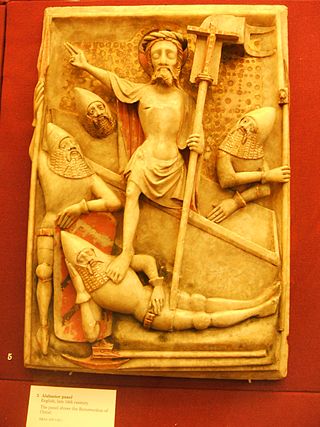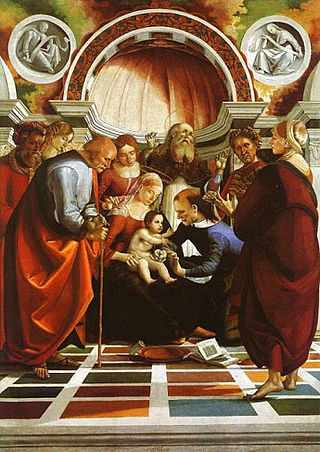Description
The iconography of the painting was rather unusual for Italy, and had been indeed inspired by Justus van Gent's Corpus Domini Altarpiece (1472–1474), that Signorelli had seen during his stay at Urbino.
Above an ancient style background, similar to Perugino's works, Signorelli painted Christ in the center of the scene, surrounded by brightly dressed apostles in a pyramidal composition. Christ holds a dish with the hosts he is delivering them. Among the apostles, Judas Iscariot is portrayed while turning towards the seer: at the same time, he is hiding into his purse the coin of his betrayal.
The altarpiece was most likely accompanied by a predella. Three of its panels have been identified with the Meeting of the Pilgrims on the Road to Emmaus and Supper in Emmaus in the Julius Weitznel collection, and with the St. Catherine of Alexandria now at the Museo Horne in Florence.

Fra Angelico, OP was a Dominican friar and Italian painter of the Early Renaissance, described by Giorgio Vasari in his Lives of the Artists as having "a rare and perfect talent". He earned his reputation primarily for the series of frescoes he made for his own friary, San Marco, in Florence, then worked in Rome and other cities. All his known work is of religious subjects.

In art a predella is the lowest part of an altarpiece, sometimes forming a platform or step, and the painting or sculpture along it, at the bottom of an altarpiece, sometimes with a single much larger main scene above, but often, a polyptych or multipanel altarpiece. In late medieval and Renaissance altarpieces, where the main panel consisted of a scene with large figures, it was normal to include a predella below with a number of small-scale narrative paintings depicting events from the life of the dedicatee, whether the Life of Christ, the Life of the Virgin or a saint. Typically there would be three to five small scenes, in a horizontal format. Sometimes a single space shows different scenes in continuous representation.

Luca Signorelli was an Italian Renaissance painter from Cortona, in Tuscany, who was noted in particular for his ability as a draftsman and his use of foreshortening. His massive frescos of the Last Judgment (1499–1503) in Orvieto Cathedral are considered his masterpiece.

Pinturicchio, or Pintoricchio, also known as Benetto di Biagio or Sordicchio, was an Italian painter during the Renaissance. He acquired his nickname because of his small stature and he used it to sign some of his artworks that were created during the fifteenth and sixteenth centuries.

Pietro Perugino, an Italian Renaissance painter of the Umbrian school, developed some of the qualities that found classic expression in the High Renaissance. Raphael became his most famous pupil.

The resurrection of Jesus has long been central to Christian faith and Christian art, whether as a single scene or as part of a cycle of the Life of Christ. In the teachings of the traditional Christian churches, the sacraments derive their saving power from the passion and resurrection of Christ, upon which the salvation of the world entirely depends. The redemptive value of the resurrection has been expressed through Christian art, as well as being expressed in theological writings.

Scenes from the Passion of Christ is an oil painting on a panel of Baltic oak, painted c.1470 by German-born Early Netherlandish painter Hans Memling. The painting shows 23 vignettes of the Life of Christ combined in one narrative composition without a central dominating scene: 19 episodes from the Passion of Christ, the Resurrection, and three later appearances of the risen Christ. The painting was commissioned by Tommaso Portinari, an Italian banker based in Bruges, who is depicted in a donor portrait kneeling and praying in the lower left corner, with his wife, Maria Baroncelli, in a similar attitude in the lower right corner.

The Last Supper of Jesus and the Twelve Apostles has been a popular subject in Christian art, often as part of a cycle showing the Life of Christ. Depictions of the Last Supper in Christian art date back to early Christianity and can be seen in the Catacombs of Rome.

The Sant'Onofrio Altarpiece is a painting by the Italian Renaissance painter Luca Signorelli, housed in the Museo dell'Opera del Duomo in the Cathedral of Perugia, Italy. It was painted for the church in 1484, commissioned by bishop Jacopo Vagnucci, a native of Cortona, Signorelli's birthplace.

The Circumcision is a painted altarpiece of the Circumcision of Jesus by the Italian Renaissance painter Luca Signorelli, in the National Gallery in London, dated to c. 1490–1491.

The Testament and Death of Moses is a fresco attributed to the Italian Renaissance painters Luca Signorelli and Bartolomeo della Gatta, executed in around 1482 and located in the Sistine Chapel, Rome.

The Virgin Enthroned with Saints is a painting by the Italian Renaissance artist Luca Signorelli, dated to 1491 and housed in the Pinacoteca Comunale of Volterra, central Italy.

The Pinacoteca Comunale ofCittà di Castello is the main museum of paintings and arts of Umbria Italian Region, alongside the Perugia's National gallery, and it's housed in a renaissance palace, generally preserved in its original form.

Crucifixion is a painting of the Crucifixion of Christ, usually attributed to Perugino, with or without assistance from Luca Signorelli. The work's dating and attribution are both uncertain - Venturi and Schmarsow attribute it to a pupil of Perugino, whilst other art historians attribute it to Perugino alone or with assistance from Signorelli. The deep chiaroscuro is comparable to Signorelli's style elsewhere or to the early style of Perugino whilst he was still heavily influenced by Verrochio. The landscape background is typical of Perugino, with mountains and hills in deep perspective.

Madonna and Child with the Holy Trinity and Two Saints is a painting by Luca Signorelli, from 1510, now in the Uffizi in Florence. It is a sacra conversazione, with the Madonna enthroned between Michael and Gabriel, with Augustine (left) and Athanasius (right) below and the Holy Trinity above.

The Arcevia Altarpiece is a 1508 oil on panel painting by Luca Signorelli, shown in the collegiate church of San Medardo in Arcevia, for which it was originally painted. It is signed below the Madonna's feet.LUCAS. SIGNORELLUS / PINGEBAT M. D. VIII

Adoration of the Magi is a painting in tempera on wood panel by Luca Signorelli (1450–1523) and his assistants, executed c. 1493–1494, and now in the Louvre in Paris. It was probably the first painting he produced in Città di Castello, and originally hung over the main altar of the monastery church of Sant'Agostino. The surface displayed within the frame is 331 cm by 245.5 cm. In late 2022 it was not on display.

Birth of John the Baptist is a c. 1485–1490 tempera on panel painting by Luca Signorelli. Originally part of the predella of an unknown altarpiece, it was acquired on the art market in 1824 by the Louvre, where it still hangs in the Salle des Sept-Mètres.

The San Giovanni Sacristy is one of four sacristies of the Basilica della Santa Casa in Loreto, located between the church's transepts. Octagonal in plan, the sacristy is decorated with a 1477–1480 fresco cycle by Luca Signorelli.

Crucifixion with St Mary Magdalene is a c. 1502–1505 tempera on canvas painting by Luca Signorelli, now in the Uffizi in Florence. It is usually held to be a late autograph work.




















